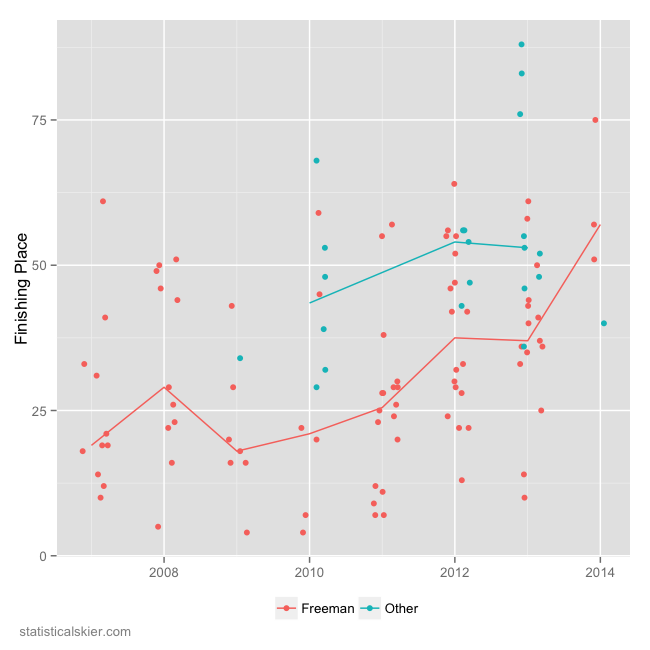One of the hot topics this week in the US is who will be named to the Olympic team. There is particularly heavy speculation surrounding the men’s distance skiers, since that’s the most wide open (and the weakest). There are a lot of factors that go into a decision like this that I’m just going to ignore: having enough racers in case someone gets sick, starting young skiers versus older skiers, etc. Those are all judgement calls.
I’m going to throw a lot of stuff into this post, but my main message here is that there really is no such thing as an “objective criteria”. I’m going to limit myself here to Kris Freeman, Brian Gregg, Matt Liebsch, Sylvan Ellefson, Erik Bjornsen and Miles Havlick. It’s possible that Bjornsen will get in based on his sprint points anyway, but I’m going to include him regardless.
The range in distance FIS points for these six is only 5.31 based on the current list. If you actually included a confidence interval on each person’s FIS points (which are an average, remember) they would encompass a range of 4-7 FIS points for each of them. So statistically speaking, that “objective” measure is essentially indistinguishable.
And of course, it is extremely sensitive to what you might call “researcher degrees of freedom“. FIS points are designed to measure one very specific thing (if you even believe they do a good job of that): how fast could someone ski, if everything goes perfectly? Even if you assume that FIS points “work” they will never measure how fast someone will typically ski. That’s baked into the cake with the decision to average each person’s five best results.
For example, if instead of averaging the best 5 results you took the median of all results over the previous year, they would be in the order Ellefson, Gregg, Liebsch, Havlick, Freeman, Bjornsen. If you take the median of the results just this season, the order would be Ellefson, Gregg, Liebsch, Bjornsen, Freeman, Havlick.
Personally, I’m more partial to using head-to-head data to compare skiers. Then you don’t need to decide whether you “believe” FIS points or not, since we’re just using (essentially) differences in percent back when they actually ski against each other.
So if you take all head-to-head matchups among those six over the past year, weight them by date, and take the median of those results, the order would be Freeman, Bjornsen, Ellefson, Havlick, Gregg and Liebsch. This last measure highlights the degree to which Gregg and Liebsch are getting good points at races that the other folks didn’t happen to be at.
Lastly, are we shuffling deck chairs on the Titanic here? Are any of these guys likely to finish in the top 30 or top 20 in Sochi? (I am not an unfeeling robot; I acknowledge that there are more sentimental reasons to name people, as a reward to excellent domestic performances, regardless of how likely they are to have success internationally.)
The following graph shows the major international distance results for this group of guys over the past several seasons. Since Freeman is responsible for so many of them, I’ve separated him out.
Nothing to write home about for anyone here, so regardless of who is named, my expectations for results are pretty low.
Just for fun, I’ll go ahead and say what I’d do in a fantasy land where I’m not bound by official selection criteria. In addition to the pre-qualified men I would name Kris Freeman, Torin Koos, Erik Bjornsen and Sylvan Ellefson. Why? Well, Freeman hasn’t been skiing well lately, but he’s the only one of the group I think actually could pop a top 10 or top 5 result if the stars aligned. Koos because you just need another sprinter, and he’s the obvious choice. Bjornsen both based on recent performance and the “youth” argument, and Ellefson because he seems to be skiing particularly well this season.

{ 2 } Comments